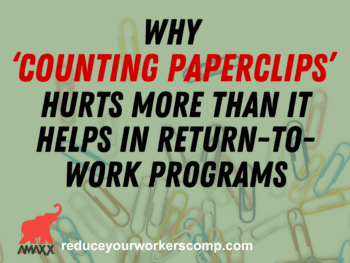
Step 1: Provide Immediate Post-Injury Medical Care
The best step toward an effective return to work program is immediate medical care following a work injury. Supervisors and other managers should ensure that first aid kits are adequately stocked and accessible. They should also be willing and trained to offer assistance to employees with even simple medical care. Other items to consider include:
- Educating all employees on the injury reporting process and having a system in place that allows the individual to report it if a supervisor is not present;
- Train other employees on how to assist with post-injury medical care when a supervisor is not present. This should be a part of annual safety training;
- Provide a telephonic nurse triage service. These services are staffed by a trained nurse who can assist employees in the diagnosis of the injury and direct medical care; and
- Access to summon emergency medical services for injuries that require an immediate response.
Nobody wants an injury to occur. It is essential to foster an environment where employees receive immediate medical assistance with respect and dignity.
Step 2: Direct Medical Care (Even if You Cannot Select the Treating Doctor)
Most jurisdictions allow employees to select their primary treating doctor following a work injury. This includes allowing the employee to receive immediate medical care and establish a primary doctor once the injury is stabilized. Although these guidelines are in place, nothing prohibits employers from directing employees to a network of doctors and specialists to receive medical care.
Employers and other interested stakeholders can stake affirmative steps to directing medical care. Steps that can be taken beyond the establishment of a treatment networking include:
- Developing a positive relationship with the employee’s health care providers. This requires the claims team to return calls and messages promptly. It also requires a clear explanation as to why care is being denied;
- Incorporate analytics into the claims process to evaluate the care received at certain health care providers. This information will allow the claims team to make better decisions and determine the next steps; and
- Effective communication with nurse case managers can also help the employee receive the proper medical care in a timely manner.
Studies indicate that injured employees who receive the correct medical care following a work injury get back to work quicker.
Step 3: Retain the Right Medical Expert – The Perfect IME
The independent medical examination (IME) is the only defense expert opportunity to refute primary liability issues, the nature and extent of a work injury, and recommendations regarding future medical care. Choose wisely,
- Offering return to work opportunities can reduce the need for the IME. This save interested stakeholders money;
- Having a complete set of medical records provides the examining expert with proper foundation;
- Writing the best cover letter possible that is entirely factual is a must. This letter will be used against the defense interests if not done correctly; and
- Timing is key. Use the IME after discovery is complete, and the employee is at or near maximum medical improvement.
Now is the time to reconsider how and when you use your IME.
Step 5: Think About Return to Work All the Time
Issues concerning return to work should be considered before the work injury and in all phases of the claim. It requires patience and coordination with all interested stakeholders. Other items to consider include:
- Appointing an employer representative as the primary contact regarding return to work issues. This person is the “quarterback” of the team and runs all efforts;
- Think outside the box in terms of what the employee can do to remain productive; and
- Keep in constant contact with the employee regarding their status and restrictions. Take steps such as providing transportation to doctor visits or playing for translation services if the employee does not speak English as a primary language.
Conclusions
Return to work efforts pay dividends in reducing workers’ compensation program costs. It also has other benefits, such as improving workplace morale and demonstrating empathy. Now is the time to think about returning your injured employees to work.

Contact: mstack@reduceyourworkerscomp.com.
Workers’ Comp Roundup Blog: http://blog.reduceyourworkerscomp.com/
©2022 Amaxx LLC. All rights reserved under International Copyright Law.
Do not use this information without independent verification. All state laws vary. You should consult with your insurance broker, attorney, or qualified professional.

















